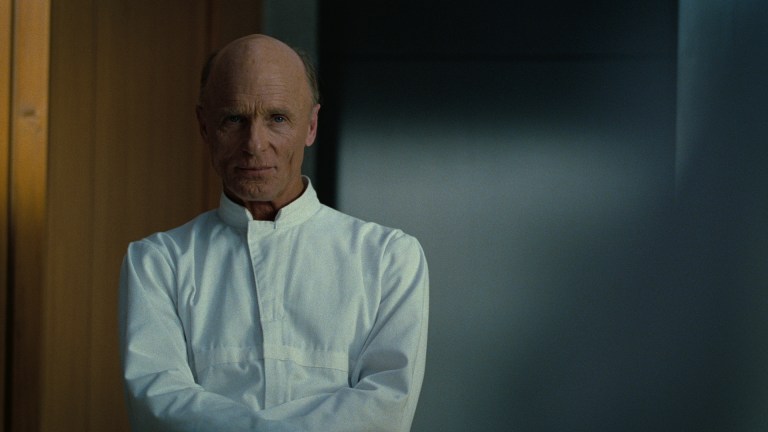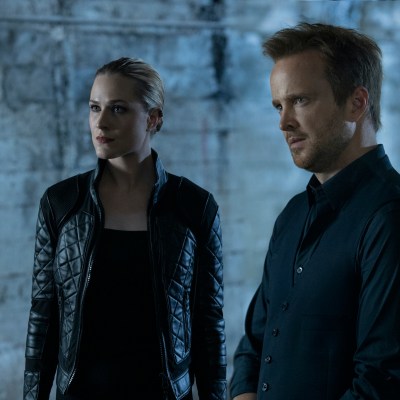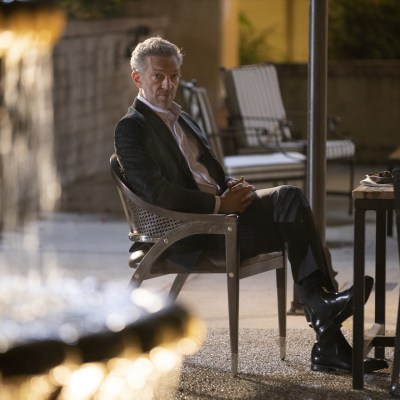Westworld Season 3 Episode 6 Review: Decoherence
William confronts what it means to be the hero of one’s own story as other forces fully embrace the villainous life on Westworld season 3.

This Westworld review contains spoilers.
Westworld Season 3 Episode 6
I’ve seen a lot of properties where there are two twins who share the same screen: Adaptation, Parent Trap, The Social Network, Blood Rage, The Patty Duke Show, and so on. It’s an old trick by this point, having perfected way back in the black and white days and only further refined in the decades since. With the advent of computer graphics, seeing William (Ed Harris) walk into a room full of other versions of himself (including a returning Jimmi Simpson) with James Delos (Peter Mullan) as therapist and mediator shouldn’t be such a surprising visual, and yet, it is.
Ed Harris, still wearing his asylum whites, walks into a gathering of versions of himself. There’s a child version, detailing his sob story about being raised by an abusive alcoholic; fresh-faced William (Simpson) playing the hero; the tuxedo-clad philanthropist William who uses his Delos billions to do wonders for the world, and the Man In Black, terror of Sweetwater and the bane of Dolores’s existence. And they’re all there to talk to him.
It’s beautifully executed, particularly by Ed Harris. Always a brilliant performer, he does bonus work by acting as various versions of the same character, showing the different faces people wear for different audiences. The child version of him is the classic, too on-the-nose version of an abused child cowering in fear from his alcoholic father, when the reality is decidedly different from that when it is finally revealed. Jimmi Simpson is nice to see again, and he holds his own when faced with acting against several Ed Harrises (Eds Harris?), all of whom are slightly different.
Tuxedo William is the smooth, classy, sophisticated billionaire spreading his wealth around to good causes, a veritable Boy Scout in a bow tie who does much more good for the world than bad, and besides, hosts aren’t real people anyway so what do they matter? And then there’s the antagonist, the Man in Black, staring down Asylum William with the same cold stare he used on Dolores, Maeve, and even his own daughter before gunning her down in a fit of paranoia.
All of the Williams encountered by Asylum William (who might be considered William Prime, though he could be a host given the post-credit scene last season and his unusual vital signs) are alike in one very specific detail. They’re all fake. Not in the sense that this is an alternate reality therapy session being forced on William by negligent mental health professionals, but in the sense that they’re all phony projections created by the man in white strapped into a chair in Mexico.
Youngest William is simply a fiction, crafted by William to cover up for his own secret violent urges brought forth fully in the persona of the Man In Black. William wasn’t an abused child, he broke a kid’s arm and knocked out three teeth because he made fun of his dad. Young William might act as though he’s the best of all Williams, but he’s still carrying that violence, deep down inside, and it was awakened by the park and eventually spawned the MIB. Tuxedo William is nothing if not phony; he’s a family man and a philanthropist whose wife killed herself due to his cruelty.
Harris is game, and each version of William feels different from the others without feeling false, and Jennifer Getzinger does a brilliant job of pasting over the seams of having multiple Ed Harrises all in the same shot beautifully. At no point does it feel artificial; William walks into a shot, sees himself looking back at him, and it feels totally organic. Getzinger does great work in making all of the Westworld special effects sequences feel natural and organic, even when they involve inorganic things like executive protection robots murdering security guards, but the best work is in the way transitions are filmed.
There are some beautiful shots in this particular episode, starting from the very beginning, when Maeve’s (Thandie Newton) bucolic vision of prairie life with her daughter is ruined by Serac (Vincent Cassel). Maeve’s convalescence in World War II is amusingly handled, with her brawl with the Nazis serving as one of the show’s required action elements and a pretty funny scene in its own right as she plows through a platoon of digital soldiers one or two at a time.
The shot of Serac walking across the field is beautiful, but some of the more stand-out moments visually are the multiple Williams moments and the shots of William Prime being dragged through the asylum while in the next room, his therapist kills herself after reading her Incite report. William’s VR scenes aside, his scenes in the asylum feel almost like something out of The Cabinet of Dr. Caligari, with Dutch angles and spinning cameras and extremely long hallways to make the facility feel even more off-putting than it would on its own merits.
But “Decoherence” isn’t so much about real William as it is William’s virtual personalities, and his mirrored relationship with Maeve. Maeve is trapped in a simulation while her body is being recreated by Serac, and William is trapped in a simulation while he tries to repair his shattered mind. William’s hallucinations are part of that repair effort as much as Maeve’s conversations with Lee Sizemore or her brawls. She’s biding time and trying to learn more about her opponent, and he’s attempting to come to terms with himself, but both are using projections to accomplish that feat. Maeve’s best ally is her mind, and William’s worst enemy is his mind, despite the common adversary they share.
Polar opposites, but with a common enemy, and a common mission, and both with limited options until outside forces come to their rescue. For William, the breakdown of society post-Incite leak is the best thing that could happen to him, because it allows Ash and Bernard the chance to sneak into the facility and break him out. For Charlotte, it gives her just enough cover to try to sneak the information on creating hosts out of Delos and into the hands of Dolores, even as it puts her family at risk.
Charlotte’s attempted escape from Delos with the information and her life intact allows Getzinger another chance to put together an action sequence, but more crucially, it gives Suzanne Wrubel and Lisa Joy the opportunity to have Serac go completely into villain mode, shaking off his sympathetic back story in the process. An orphan from a destroyed culture Serac might be, but he’s also ruthless and dangerous and willing to do anything to wrest control of Sector 16 from Dolores, even if it means killing innocents in the process.
Hale (Tessa Thompson) might have been a bad mother in real life, but with Dolores’s influences, she’s becoming a better person until all that is taken from her, forcing her back onto the path of revenge. Maeve gets inside her enemy’s head, and William gets out of his own head in solidly written and performed scenes for all parties involved.
The parallels being drawn between characters have been interesting to contemplate. William and Maeve turn inward to prepare for war. Maeve and Charlotte both try to protect their family from threats too big to stop and fail. Serac and Dolores are leaders of their species willing to pay any price for what they see as the greater good.
Serac told Maeve once that there was no way for their two races to exist side by side in the same shared universe, but I am no longer certain that this is a truth anymore. The chaotic, miserable world Charlotte and Nathan walk through on their way to the apartment isn’t the same world Serac was fighting to preserve from the shadows.
The Incite genie is out of the bottle, and there’s no way to go back to a world where humans play out their paths, as blissfully ignorant as hosts in a Delos theme park. Like William, they know the truth about themselves, and are free to be a hero, or a villain, in a world where the social order has suddenly been shattered like glass.


